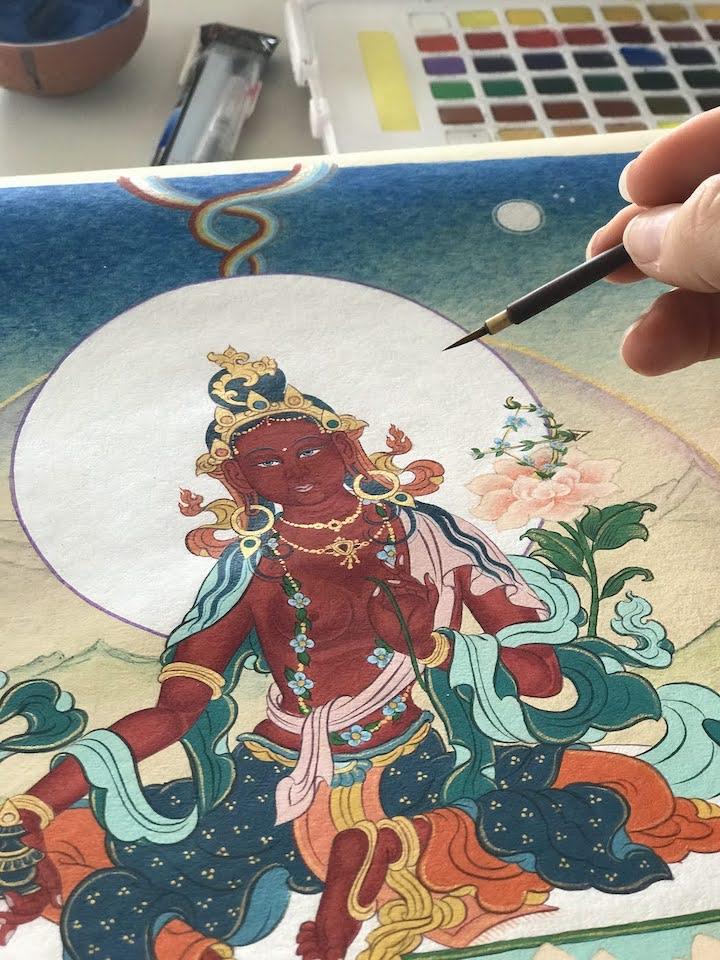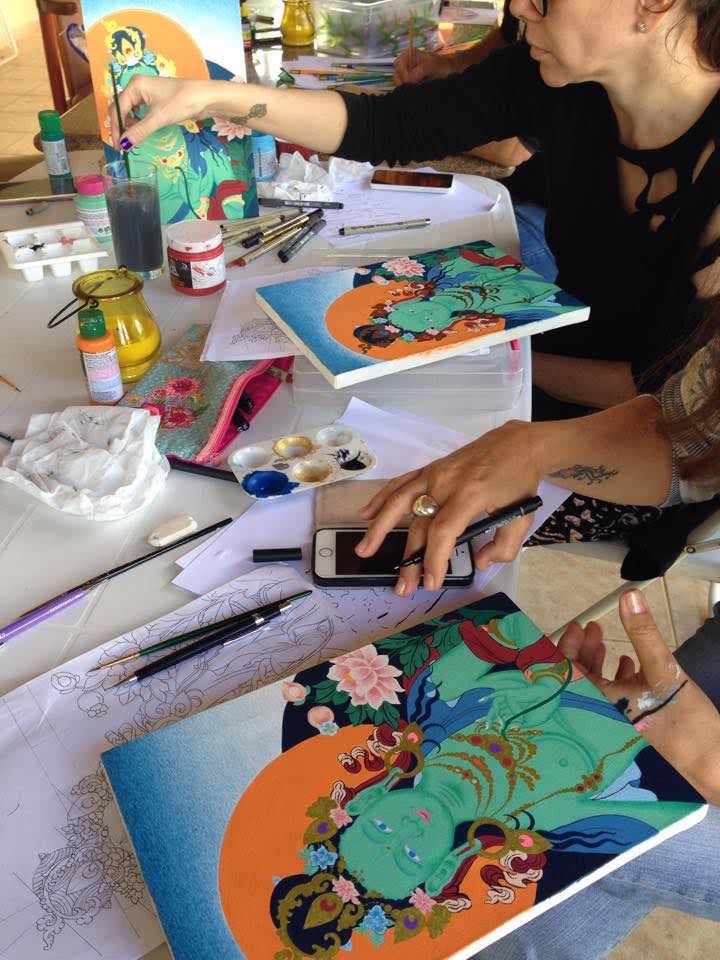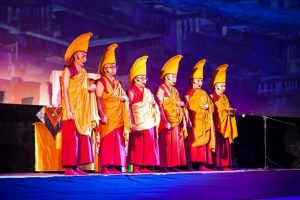
One thing we know for sure: every sentient being developed and came out from a female body. The female body was made by nature to receive an invisible seed in the fertile inner soil of her womb, fed by juices that only nature knows until finally, at the right time, she spreads her bones in ravishing pain and lets a new being pass into the world like a shooting star. The eyes of the woman who has just became a mother open in unquestioning love, like a flower opening to the wild sky, inevitably. Her body produces sweet, nourishing milk to sustain the new life so that when the child is strong he can run his own way in the world, leaving his mother in prayer. We all carry our mothers milk within our veins.
Let us look at what is closer to us in order that we might contemplate the buddha-deity Arya Tara, who at first approach can seem unattainable and sometimes beyond mere concepts. But just as I have described above the inevitable forces of existence that a woman’s body is made to channel to continue the cycle of life, we can find the same power within our minds and within our hearts. When Siddhartha Gautama, in one of his past lives, gave his own flesh to feed a hungry tigress, he was opening in love and dissolving in love to serve the cycles of existence. Such a manifestation is an attribute of the archetype of the Great Mother: love, compassion, donation, nourishment, altruism, hope, intuitive wisdom, and liberation.
When we think of Tara, we should remember our own mothers in their deepest virtuous potency. Even if we don’t have the best relationship with our mother, she inevitably served her body, her flesh, milk, and those of her ancestors too, to give us this life. Even if she doesn’t understand it on a conceptual level, every woman carries within her the potency of the archetype of Arya Tara. Men can too, but it’s easier for those in a woman’s body to get in touch with their enlightened essence. This has to do with a vow she made to always be reborn in a female body and to help all sentient beings as a bodhisattva. In absolute reality, it doesn’t matter if one is a man or a woman, but in relative reality it matters—especially because we are in a time cycle of human society when the female body is mostly violated on so many levels. Men who devote their practice to Tara will dissolve in her love essence and will also be able to manifest her compassionate activity in a tender and incredibly altruistic way.
Arya Tara can be seen as the enlightened archetype of pure feminine energy (independent of gender—all of us manifest both polarities). And if we could give a “face” to true liberation through love and compassion, the Tibetans, and even those before them in India, had divine visions of the embodiment of compassion, and created art in a way that anyone with intention and merit can approach and eventually embody her archetype of liberation.
We know that the essence of compassion can be experienced in any part of the world, independent of culture, tribe, or creed, or language. What we are accessing is the same essence—and for this essence tantric believers gave the name Tara. Giving it a form and a name helps us to approach her and become her. Not only through embodying her qualities; one can also attain great bliss by devotion and prayer toward her image. If one prays fervently and makes offerings full-heartedly, such love is already the expression of Tara. It provokes one to surrender and inspires all beings who approach her to awaken the seed of altruistic love, rapid activity to liberate, and wisdom to guide. Because all of us have the seed of our mothers within us, and the mothers of our mothers, if we purify and nourish it with great intention, love will grow like a tremendous peach tree, feeding all beings surrounding it.
Arya Tara’s most common expression is her green color, representing the Karma family that is associated with Amoghasiddhi Buddha. Amoghasiddhi is the buddha of the air element, which moves in action but it is invisible, like the wind that we do not “see” but perceive through the trees moving on a windy day. Tara’s 16-year-old appearance represents the freshness of an awakened mind and the Dharma that never grows old. Her eyes have the shape of sweet almonds, twinkling in the humidity of unconditional love.
She sits upon a lotus throne, like all buddhas and bodhisattvas who are not stained by the mud of karmic causes yet dwell in samsara, like the pure lotus that is not stained by the mud of the pond from whence it came. One of her legs is crossed in meditation, but the other is extended, her right foot resting on a lotus pedestal, as if ready to stand at any moment. This is the “game posture” showing her readiness, attentiveness, and disposition to do anything in support of liberation from suffering. She has two arms: her right hand is resting on her knee in the mudra of generosity. The other holds the stem of a lotus flower, which opens next to her face, this hand is in the mudra of granting refuge in the three jewels: the Buddha (teacher), the Dharma (truth), and the Sangha (community).
The lotus that she holds in front of her heart usually has three buds, one fully bloomed, one half open, and the other closed, representing the past, present, and future, which she experiences simultaneously. Tara is adorned with divine silks and golden jewels and with precious stones, and her body is a little twisted, as if in motion or dance, showing that her essence flows in constant activity. Most buddhas, for example, are depicted with a stretched and aligned back, showing that their essence flows in the practice of meditation.

Om Tare Tutare Ture Swaha.
Green Tara’s mantra is usually repeated in cycles of 108, One can recite it without any special initiation, unlike some other Buddhist deities. When one recites her mantra, one can remember that these words have been repeated through the lips of innumerable enlightened beings for thousands of years, and we are able now to become part of this current of compassionate energy and the immeasurable blessings that flow through each of our cells. Even for people who did not experience love from their mothers or for whom not enough love was shown in their lives, through this practice of mantra recitation and visualizing Tara loving you, taking you in her arms, crying out of so much love, supporting and guiding you with clear wisdom and incorrupt love, one will experience incredible joy and love filling their lives. Even when life brings you hard times, this is how she trusts in your own strength. Especially during hardship is when compassion and wisdom are called to be lived. When we understand this, we become real daughters and sons of Arya Tara.
Arya Tara, the seed essence of all other manifestations of Tara, is expressed in many other colors, including white, red, yellow, black, and blue. Most are peaceful, but some have a semi-wrathful visage, just like the many faces our own mother can express, or even ourselves—sometimes immensely tender and sometimes furious and protective. Tara can also be displayed in an assembly of 21 Taras for specific practices.
The best way to interpret any unknown deity is firstly by listening to our intuition. Does she have a kind smile? Then she is most likely a benevolent expression of energy. Is this not a smile, but more like laughter with scary teeth and an intimidating look? What do you feel? The subtle energy that arises when you look at her appearance is the energy she will be awakening and refining for better use. We should know that all deities in the tantric pantheon are symbols and paths of enlightenment, and there are infinite paths to enlightenment as there are infinite sentient beings.
Green Tara is one of the most popular deities in Tibetan Buddhism, and so too is White Tara. White Tara is very similar, with some specific differences: first she is white like the moonlight and has both of her legs crossed in meditation, but her body is also slightly twisted in gentle dance. I have learned that the more contact with the ground a deity has, the more approachable she is. Green Tara, for example, has one foot closer to the ground, meaning she’s closer to beings in samsara. White Tara promotes a more contemplative, internal, and subtle practice to be attained.
Besides a pair of common eyes, White Tara also has a vertical third eye on her brow, and one eye in each of her palms and on the soles of her feet, totaling seven. Many describe the meaning of her first three eyes as the perfection of her body, speech, and mind, and the other four as the Four Immeasurables: compassion, loving-kindness, empathy, and equanimity. But again, we can sense their meaning. Horizontal eyes look at the world as we know it with our own senses. The vertical eye connects heaven and Earth, also representing the experience of melting in union with the deity. The eyes on her hands and feet “see what she touches” and she “sees where she walks.” There is no way to hide from the wisdom that sees from all angles and realms as White Tara does. Not that other Taras don’t have the same capacity; the symbolic attributes that one has do not cancel other qualities, they add to the specific role a deity will be directing in the practice.
White Tara is commonly called upon with the wish of long life with the intent to practice for a longer time, considering all the accumulated wisdom and experiences one attains in a lifetime with the intention of benefitting more beings. Her mantra can be recited just as described before, being slightly longer than that of Green Tara:
Om Tare Tutare Ture Mamayuh Punya Jnana Pustim Kuru Swaha.

In fact, there are so many doors and bridges we can cross away from suffering and toward the side where our only concern is not merely for ourselves. We have experienced and perhaps realized that every time we are not content it is because some wish of ours was not granted. We expect life to be a certain way; we expect people to be a certain way; and when things flow in different ways we become miserable. We need the practice of love, of true empathy, which enables us to see and hear others, to feel what others feel, to communicate while considering the needs of others, to be mature, patient, kind, and firm. If we do not do something to awaken from the “self-trance” that we gravitate toward, we will never be happy and never make others happy. We can have a house but never a home, we can have a bed but no sleep free of concerns, we can posses a watch but no time, we can have a book but no knowledge, we can have a title but no respect, we can have sex but no love . . . What moves us in life is the quest to awaken from this self-trance, but due to our ignorance we search in misguided and lazy ways.
So, if you are searching for love and to be loved, make sure you are a source of love for others. If you are searchinbg for rest, learn to let worries rest so that you can sleep anywhere. Include other people at your dinner table and cook with love, and you’ll have a generous home. In sum, become what you long for; don’t demand or expect, do not hide in the shadows praying for light. Walk your way and expose yourself to the Sun; become the Sun. Create your reality by becoming a living symbol of what you long for, and eventually become a source of it for all living beings. This is Tara.
See more
Related features from BDG
The Meaning of Mandalas
Opening to Beauty
The Mandala of the Five Dancing Wisdoms within Our Hearts

















Thank you for this amazing article.The last paragraph really resonated with me for this is what Tara has also taught me. To bring light is to be the light.